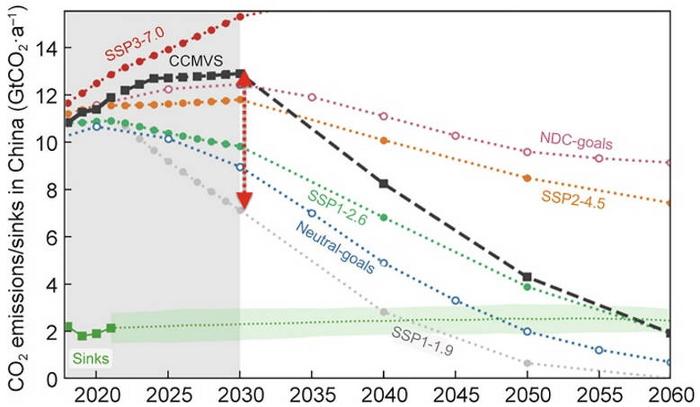A recent study published in the journal Engineering has provided significant insights into China’s carbon neutrality strategies and their alignment with the Paris Agreement’s targets. As the world increasingly acknowledges the necessity of limiting global warming, China, one of the largest greenhouse gas emitters, finds itself at a crucial crossroads. The comprehensive analysis conducted by a team of researchers explores the complex landscape of carbon emissions in China, focusing on the intricacies of the nation’s transition towards carbon neutrality and its implications for global climate health.
The Paris Agreement, which aims to limit global temperature rise to well below 2°C above pre-industrial levels, represents a pivotal framework for international climate policy. This research highlights the challenging pathway China must navigate to adhere to the agreement’s ambitious 1.5°C target. The findings suggest that while achieving the more stringent 1.5°C target is technically possible, it may impose economic burdens that are disproportionately high. The consensus among researchers indicates that the costs associated with reaching this target could escalate to three or four times those required for the 2°C objective.
China’s current trajectory suggests that its carbon emissions will peak around 2028 to 2029, with estimates placing this peak at approximately 12.8 billion tonnes of CO₂. This anticipated peak marks a crucial turning point in the nation’s approach to tackling climate change. Following this peak, a downward trend in emissions is anticipated, driven by a robust strategy focused on renewable energy and a comprehensive overhaul of the energy system. The report emphasizes the importance of transitioning to renewable energy sources, which could significantly aid China’s endeavor to achieve carbon neutrality by 2060.
Moreover, the role of carbon sinks, particularly terrestrial ecosystems, is vital in mitigating emissions in China’s journey toward sustainability. The study indicates that these natural carbon sinks could contribute up to 2.1 billion tonnes of carbon sequestration annually. However, the reliance on these ecosystems as primary emission offset mechanisms is cautioned against; their effectiveness can diminish over time, especially as climate conditions continue to worsen. Therefore, while carbon sinks will play a supporting role, the primary focus must remain on comprehensive emission reduction strategies.
Among the critical discussions raised within the study is the concept of climate overshoot. The researchers highlight that negative-emission technologies will likely need to be part of future plans. However, the study argues against the immediate large-scale implementation of such technologies, positing that they are economically unfeasible at this stage. Instead, the researchers call for accelerated advancements in renewable energy technologies and a systematic adjustment of China’s industrial framework, shifting focus from fossil fuels to sustainable alternatives.
As China progresses towards its carbon peak and ultimate goal of carbon neutrality, it stands to profoundly influence global climate strategies. The potential global impacts of this transition include stabilizing greenhouse gas emissions at a level capable of controlling global temperature rise and mitigating the risks of reaching dangerous climate tipping points. Furthermore, this transition could have a crucial role in lessening the frequency and severity of extreme weather phenomena, although the inherent complexities of the climate system must be acknowledged.
In addition to the environmental implications, the study delves into the socio-economic dimensions of climate action in China, particularly framing the context of equity in its efforts to achieve carbon neutrality. The researchers point out that China’s substantial population and vast economic landscape could complicate efforts, particularly when addressing methane emissions, which have significant short-term warming potential. Nonetheless, the commitment to carbon neutrality resonates with China’s broader development philosophy, providing a potential pathway toward a new model of green development that aligns economic growth with environmental sustainability.
This comprehensive approach puts forth critical insights, not only relevant for China but for the global community aiming to combat climate change effectively. By examining China’s unique challenges and outlining clear pathways forward, this study serves as a vital resource for policymakers, researchers, and stakeholders interested in the dynamics of international climate agreements and their practical implications on world scales.
Information about the study can be accessed in full through the open-access journal Engineering. Further engagement with this research can be pursued through social media platforms to remain informed about ongoing discussions regarding climate strategies and technological advancements in sustainability.
Subject of Research: Carbon neutrality pathways in China
Article Title: China Can Achieve Carbon Neutrality in Line with the Paris Agreement’s 2 °C Target: Navigating Global Emissions Scenarios, Warming Levels, and Extreme Event Projections
News Publication Date: 3-Dec-2024
Web References: https://doi.org/10.1016/j.eng.2024.11.023
References: Engineering Journal
Image Credits: Credit: Xiaoye Zhang et al.
Keywords
Environmental sciences, carbon neutral pathways, renewable energy, climate change, emissions reduction.
Tags: 1.5°C climate target challengesChina carbon neutrality strategiesclimate change research findingseconomic implications of carbon reductionenvironmental impact of industrializationglobal warming mitigation effortsgreenhouse gas emissions Chinainternational climate policy frameworksParis Agreement climate targetspeak carbon emissions timelinesustainable development in Chinatransition to carbon neutrality





